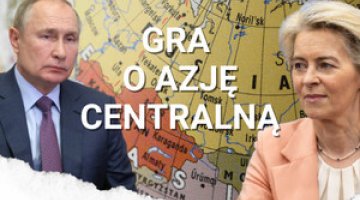The China–Central Asia Summit. Beijing is still forced to cooperate with Moscow
On 17–19 May, the city of Xi’an in China hosted the second summit of the leaders of five Central Asian countries, Kazakhstan, Kyrgyzstan, Uzbekistan, Tajikistan, and Turkmenistan, and the People’s Republic of China (PRC) (the first of these summits was held in the form of a videoconference). Until 2021, the meetings had been held at the foreign ministers’ level, but it has now been decided to permanently upgrade the event to meetings of the heads of state. These will take place every two years.
On the occasion of the summit, four of the presidents – Kazakhstan’s Kassym-Jomart Tokayev, Kyrgyzstan’s Sadyr Japarov, Uzbekistan’s Shavkat Mirziyoyev and Tajikistan’s Emomali Rahmon – paid official state visits to China. (The leader of Turkmenistan, Serdar Berdimuhamedov, visited China this January; see ‘Turkmenistan's President visits Beijing: Chinese gas diplomacy’). During individual meetings with the Chinese leader Xi Jinping, numerous deals were struck, and letters of intent were signed regarding bilateral cooperation in the fields of economy, trade, conventional and green energy, transport, agriculture, communication, and people-to-people exchanges. Xi Jinping also announced that his country would provide the Central Asian states with a total of $3.8 billion in financial support and subsidies (the period of time was not specified). In addition, it was declared that Tajikistan would be granted a loan of $500 million to construct a waterpower plant in Rogun, and that ‘non-repayable aid’ would be offered to Kyrgyzstan.
The final communiqué and the statements made after the bilateral talks suggest that issues of regional security and stability were also discussed, including what form of relations should be developed with the Taliban, ruling in Afghanistan. However, no agreements on enhancing China’s involvement in the security of Central Asia were signed during the summit. The final communiqué mainly contains vague calls for stepping up economic cooperation by harmonising the participants’ development strategies. The PRC also declared its support for the government models currently operating in the countries of Central Asia, as well as its opposition to ‘colour revolutions’.
Commentary
- By upgrading the format of the meetings, Beijing is suggesting that it wants to play a more independent role in Central Asia. This is a consequence of the clear weakening Russia has suffered as a result of its aggression against Ukraine and the Western sanctions resulting from it, as well as the consequent undermining of Moscow’s ability to shape the security situation in the region (including military interventions), which had been an important element of the Sino-Russian condominium in Central Asia. China currently does not have the military capabilities to replace the Russian Federation, so it is trying to increase its political and economic presence in Central Asia, which was the purpose of the Xi’an summit. Beijing is aware of its own shortcomings in the security area and is also unwilling to radically revise the mechanism of Sino-Russian dominance in the region, which has been operating effectively for years, and whose primary goal (apart from stabilisation) is to block the intensified activity of the European Union and the US, as well as Turkey and the United Arab Emirates.
- The decisions to raise the summit to the presidential level and to receive the leaders of Central Asia (especially the president of Kazakhstan) with exceptional splendour have a propaganda dimension, and are intended to symbolise the strengthening of the states’ mutual ties under Beijing’s auspices. This is also intended as a subtle message that the authoritarian governments of the region and the Chinese regime share common interests, and was intended to neutralise the traditional anti-Chinese resentment present there. Xi Jinping once again declared his support for the sovereignty and territorial integrity of the Central Asian states and his opposition to other actors interfering in their internal affairs. This can be interpreted as a signal to both the West and Russia. Xi’s visit to Kazakhstan in September 2022, which took place when relations between Moscow and Astana were quite strained, should also be taken in this spirit (see ‘Against the backdrop of war. The Shanghai Cooperation Organisation summit in Samarkand’). The Central Asian leaders also reaffirmed their commitment to the One China Principle promoted by Beijing, according to which Taiwan is considered an integral part of China.
- As regards security, Beijing’s priority is to prevent the emergence of democratising processes in the countries of the region. This was reflected in the declarations on closer cooperation in the area of counteracting potential ‘colour revolutions’. This is also a signal to the West, as it resonates with the joint statement on the matter made by Xi Jinping and Vladimir Putin in March this year. The leadership of the Chinese Communist Party (CCP) fears both the destabilisation of the region and undesirable inspiration for Chinese society. The second goal is to ‘tame’ the Taliban regime in Afghanistan. On the one hand, it is about stabilising Afghanistan itself so that it does not become an element disrupting peace in the region, and on the other, it is about containing Islamic fundamentalism. To achieve this, Beijing needs to actively cooperate with Central Asian states. However, Beijing’s increased interest in security issues does not translate into actions aimed at usurping Moscow’s role as a guarantor of regional security due to its lack of capacity in this area. The fact that no significant agreements covering new mechanisms or instruments in this field were signed at the summit is proof of this. This also means that China will remain open to coordinating security matters with Russia, which itself still has a military presence in the region, including bases in Kyrgyzstan and Tajikistan.
- The Xi’an summit has confirmed that the Central Asian countries are interested in developing trade, in Chinese investments, and in Chinese loans to finance the investments. Since the collapse of the USSR, China has been gradually increasing its economic presence in the region – mainly at the expense of the Russian Federation – and this process has accelerated since he Russian aggression against Ukraine on 24 February last year; according to Chinese data, the trade volume between Beijing and Central Asian countries reached $70 billion in 2022. For this reason, a number of agreements and arrangements to facilitate trade and investments were signed during the summit. The latter are expected to accelerate the implementation of projects which form part of the Belt and Road Initiative. One of its goals is to improve land transport to Europe and the Middle East, bypassing Russia (Trans-Caspian International Transport Route) and expand its capacity. It will also serve as an alternative to sea routes, albeit one which is limited in terms of quantity. Tajikistan seems to be the region’s only country making efforts to slow down this process. A reference to this was made in the Chinese communiqué on President Rahmon’s talks with the Chinese prime minister Li Qiang (Rahman was the only leader to hold an additional meeting with a senior Chinese official before the summit formally began).
- Energy remains the main field of cooperation between China and the Central Asian countries. The latter have undertaken to secure oil and natural gas supplies, while at the same time ensuring the uninterrupted operation of the Kazakhstan-China oil pipeline and the Central Asia-China gas pipeline. At the same time, the leader of the PRC expressed the need to speed up work on the construction of the fourth branch of the gas pipeline (which will connect Turkmenistan, Uzbekistan, Tajikistan, Kyrgyzstan, and China). No deals to this effect were struck, though, at least according to official announcements. Moscow’s increased interest in selling gas on the Chinese market is worth mentioning in this context. Last autumn, the governments of Kazakhstan and Uzbekistan received a proposal to build a new transit gas pipeline (via Kazakhstan) or to make the existing Kazakh and Uzbek transmission infrastructure available for transporting Russian gas to China. This move might improve Russia’s negotiating position with China on other gas projects (including Power of Siberia II, which runs through Mongolia). Both Astana and Tashkent reacted sceptically to this proposal, and the current talks – which were reinforced by the conclusion of bilateral ‘road maps’ on cooperation in the gas sector in January this year – concern supplies from Russia for the internal markets of Kazakhstan and Uzbekistan. The summit did not bring any breakthrough that suggests Beijing has decided to increase imports of energy resources from Central Asia or supports Moscow’s ‘gas’ pressure on those countries.





